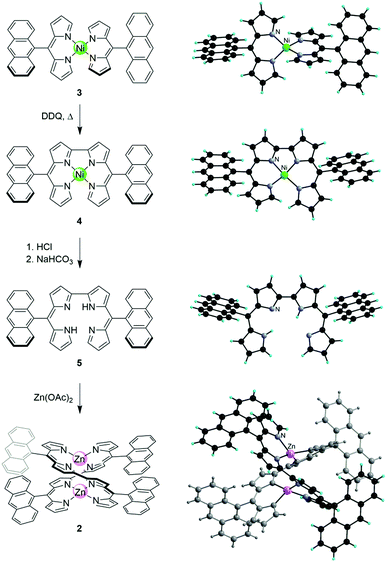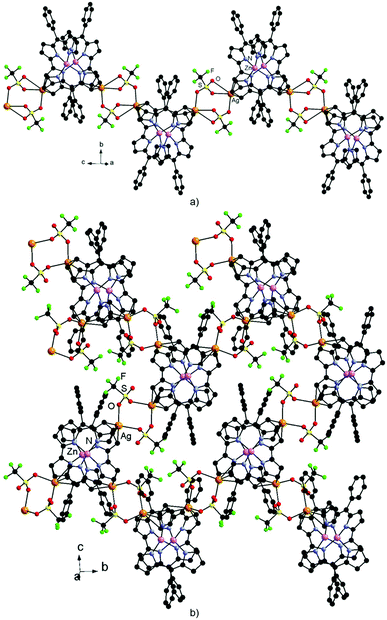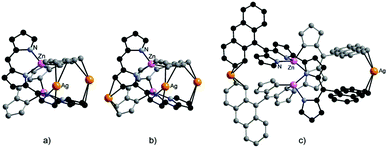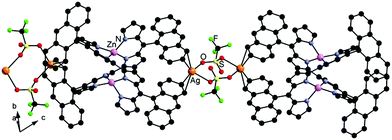 Open Access Article
Open Access ArticleCreative Commons Attribution 3.0 Unported Licence
Pre-organization of clefts for Ag–π interactions in Zn(II) bisdipyrrin helicates for the construction of heterometallic networks†
Stéphane A.
Baudron
* and
Mir Wais
Hosseini
*
Laboratoire de Tectonique Moléculaire, UMR CNRS 7140, icFRC, Université de Strasbourg, F-67000, Strasbourg, France. E-mail: sbaudron@unistra.fr; hosseini@unistra.fr; Fax: +33 368851325; Tel: +33 368851323
First published on 11th October 2016
Abstract
Coordination of 2,2′-bisdipyrrin based ligands to Zn(II) cations leads to the formation of binuclear helicates with pre-organized pyrrolic strands as well as peripheral aromatic moieties for Ag–π interactions, thus affording crystalline heterometallic networks upon further interactions with Ag(I) salts without the assistance of additional heteroatom-based coordinating units.
Since it was first hypothesized by Hill and later confirmed by crystallographic investigation,1 Ag–benzene interaction and more generally Ag–π interactions have been intensely studied,2 used for sensing in solution3 and in the field of coordination networks.4 Combinations of polyarenes with a variety of silver salts have been particularly explored to generate infinite crystalline architectures. Contrastingly, polypyrrolic ligands have been much less investigated in this context. Studies in solution have demonstrated the ability of these backbones to interact with Ag(I) cations.5 Ag–π interactions in the solid state have been recently documented.6–8 The large majority of these examples are based on the association of silver salts with metal complexes incorporating bis-pyrrolic dipyrrin9 type ligands bearing peripheral coordinating units.7 However, a lack of control of this interaction was observed and, in some cases, polymorphism was detected affording, under the same crystallization conditions, extended architectures featuring such a complexation mode and other architectures without.7c In order to promote this interaction, it seemed to be interesting to increase the number of complexation sites and more importantly to pre-organize them in a favourable disposition. In this regard, binuclear helicates resulting from the complexation of Zn(II) cations by tetrapyrrolic 2,2′-bisdipyrrin ligands appeared to be appealing,10 since they feature four π clefts formed by the pyrrolic rings of the two different strands (Scheme 1). Upon assembling a benzonitrile-appended helicate with a series of silver salts, the anticipated complexation of the Ag(I) cations by pyrrolic groups affording tetranuclear Zn2Ag2 discrete motifs was observed. The latter further self-assemble into networks, owing to the additional coordination of the nitrile units to silver cations.8
Interestingly, the earlier reports on homometallic systems using polyarenes solely took advantage of the pre-organization of Ag–π interaction sites by covalent bonding,2,4a without any stabilizing additional coordination of heteroatom-based units. It would be of interest to form analogous heterometallic networks in a similar manner, using helicates bearing unfunctionalized arene groups. In this respect, it should be noted that, in the binuclear Zn(II) helicates formed by combining 2,2′-bisdipyrrin ligands with Zn(II) cations in a 2/2 ratio, not only are the polypyrrolic strands pre-organized but also the peripheral moieties. Considering that the latter can be extended aromatic moieties, such as anthracene for example, they can also be regarded as a second interaction site for Ag(I). This concept is illustrated herein using phenyl- and anthracene-appended species, 1 and 2 (Scheme 1), allowing the formation of heterometallic networks solely resulting from Ag–π interactions with either the pyrrolic strands or the peripheral aromatic groups and without the assistance of additional binding units.
Helicate 1 was synthesized as described earlier,10e whereas complex 2 was prepared following the synthetic route developed by Scott et al. (Fig. 1).11 Upon reaction of Ni(II) complex 3,12 with DDQ, compound 4 was obtained in 62% yield. Demetallation by treatment with HCl, followed by NaHCO3, afforded the 2,2′-bis-dipyrrin ligand 5 in 91% yield. Subsequent reaction with one equivalent of Zn(OAc)2(H2O)2 in a CHCl3/MeOH (1/1) mixture led to the formation of the target helicate 2 in 73% yield. All compounds were characterized by 1H-, 13C-NMR and UV-visible spectroscopies in solution, mass spectrometry and single-crystal X-ray diffraction (see the ESI† for details).
 | ||
| Fig. 1 Synthetic pathway for the preparation of helicate 2 (left) and crystal structures of the intermediates and the final compound (right). Solvent molecules have been omitted for clarity. | ||
Although the Ni(II) cation is in a pseudo-tetrahedral environment in 3, it adopts a distorted square-planar geometry in 4, as highlighted by the angle between the two dipyrrin chelates evolving from 45.3° to 19.2°, with a helical arrangement of the bis-dipyrrin ligand around the metal center (Fig. 1). The effect of the bond formation between the two dipyrrins is also apparent when comparing the Ni–N distances. They range from 1.885(2) to 1.898(2) Å in 3, while two are significantly shorter than the others in 4 (1.847(3) and 1.859(3) vs. 1.883(3) and 1.893(3) Å) as previously observed for other reported complexes.8,10h,11,13 For the free 2,2′-bisdipyrrin ligand 5, the four pyrrolic rings are coplanar and the two dipyrrin chelates are in a cis arrangement as reported for other analogous derivatives.10h For helicate 2, two Zn(II) cations, separated by 3.326(3) Å, adopt a distorted tetrahedral geometry with the chelates forming an angle of 72.7°. Within a helical strand, the two dipyrrin units form an angle of 44.3°. The compound crystallizes in the P2/c space group with both P and M helical twists. In all four compounds, the peripheral anthracene group is perpendicular to the bis-pyrrolic backbone, as observed in the structure of the parent dipyrrin.12 In helicate 2, as anticipated, two aromatic groups face each other with the shortest C–C distance of 3.409 Å (Fig. 1).
The assembly of helicates 1 and 2 with silver salt in the solid state was then investigated. Upon Et2O vapour diffusion into a toluene solution of a mixture of 1 with an excess of Ag(TfO), crystals of either network 6 or 7 were obtained after few days and characterized by single-crystal X-ray diffraction. It should be noted that the formation of crystalline materials composed of 6 or 7 was delicate and only a few crystals could be obtained, preventing thus further batch characterization. The formation of network 8, by Et2O vapour diffusion into a o-xylene solution of a mixture of 2 with an excess of Ag(TfO), was consistent and produced enough crystals for full characterization (see the ESI† for details). For all three polymers, binuclear (AgTfO)2 units are complexed by the helicates through Ag–π interactions with π-clefts formed by either the pyrrolic strands, in 6 and 7, or the peripheral anthracene units in 8 (Fig. 2–4).
Network 6, formulated as [1(AgTfO)2]2(Et2O)3, crystallizes in the centrosymmetric monoclinic space group P21/n (Fig. 2a). Two Ag(I) cations are bridged by two TfO− anions with Ag–O distances ranging from 2.351(3) to 2.911(3) Å. For both metal centers, the coordination sphere is completed by interaction with C![[double bond, length as m-dash]](https://www.rsc.org/images/entities/char_e001.gif) C bonds of two pyrrolic rings belonging to the two strands of helicate 1 with Ag–C distances within the 2.396(4) to 2.539(4) Å range. These distances are in agreement with the ones observed with other mono- and bis-dipyrrin complexes.7,8 Each helicate binds two silver cations via Ag–π interaction in a 1,2-arrangement (Fig. 3a). It is worth noting that the Zn–Zn distance (3.186(4) Å) within the helicate is shorter than the one reported for the free compound, 3.243 Å.10e The overall organization is a 1-D polymer with alternating P and M chirality along the c axis (Fig. 2a). In the crystal, these neutral chains are separated by Et2O solvate molecules.
C bonds of two pyrrolic rings belonging to the two strands of helicate 1 with Ag–C distances within the 2.396(4) to 2.539(4) Å range. These distances are in agreement with the ones observed with other mono- and bis-dipyrrin complexes.7,8 Each helicate binds two silver cations via Ag–π interaction in a 1,2-arrangement (Fig. 3a). It is worth noting that the Zn–Zn distance (3.186(4) Å) within the helicate is shorter than the one reported for the free compound, 3.243 Å.10e The overall organization is a 1-D polymer with alternating P and M chirality along the c axis (Fig. 2a). In the crystal, these neutral chains are separated by Et2O solvate molecules.
 | ||
| Fig. 2 Portion of the 1D network in the structure of 6 (a) and of the 2D network in the structure of 7 (b). Hydrogen atoms and solvent molecules have been omitted for clarity. | ||
 | ||
| Fig. 3 Details of the Zn2Agx cores (x = 2, 3) in 6 (a), 7 (b) and 8 (c). The peripheral phenyl groups have been omitted for clarity in (a) and (b). | ||
Interestingly, under the same reaction conditions, crystals of network 7 were also obtained. This compound, formulated as [1(AgTfO)3], also crystallizes in the centrosymmetric monoclinic space group P21/n (Fig. 2b). Once again, silver cations form binuclear units owing to the bridging of triflate anions with Ag–O distances varying from 2.357(3) to 2.476(3) Å. These neutral (AgTfO)2 cores are complexed by helicate 1via Ag–π interaction with Ag–C distances slightly longer than in 6 (2.405(3) to 2.683(3) Å). Each Zn(II) complex is bound to three Ag(I) cations, leading to an overall 2-D organization, with alternating P and M chirality (Fig. 2b). The latter can be described, by analogy with the above mentioned network 6, as 1-D chains formed by complexation of (AgTfO)2 units by helicate 1 in a 1,2-arrangement along the b axis, further connected here by a third binuclear silver based unit (Fig. 2b). The arrangement of the ligands and Zn(II) cations within helicate 1 itself does not strongly differ from what is observed for 6 (Fig. 3), except again for a shorter Zn–Zn distance (3.208(2) Å) compared with the free complex.
Network 8, formulated as [2(AgTfO)2]2(o-xylene)(Et2O)5, crystallizes in the triclinic P![[1 with combining macron]](https://www.rsc.org/images/entities/char_0031_0304.gif) space group (Fig. 4). As for the two previous extended architectures, silver cations form binuclear units bridged by TfO− anions with Ag–O distances between 2.358(3) and 2.436(3) Å. The units are complexed by helicate 2via Ag–π interaction with pairs of peripheral anthracene groups (Fig. 3c and 4), leading to a 1D network with alternating P and M helices. The Ag–C distances range from 2.411(4) to 2.567(4) Å. In networks 6 and 7, the Ag(I) cations interact consistently with the same C
space group (Fig. 4). As for the two previous extended architectures, silver cations form binuclear units bridged by TfO− anions with Ag–O distances between 2.358(3) and 2.436(3) Å. The units are complexed by helicate 2via Ag–π interaction with pairs of peripheral anthracene groups (Fig. 3c and 4), leading to a 1D network with alternating P and M helices. The Ag–C distances range from 2.411(4) to 2.567(4) Å. In networks 6 and 7, the Ag(I) cations interact consistently with the same C![[double bond, length as m-dash]](https://www.rsc.org/images/entities/char_e001.gif) C bond of the pyrrolic ring, whereas the situation is different in the structure of 8. Indeed, one Ag(I) center interacts with the outer C
C bond of the pyrrolic ring, whereas the situation is different in the structure of 8. Indeed, one Ag(I) center interacts with the outer C![[double bond, length as m-dash]](https://www.rsc.org/images/entities/char_e001.gif) C bonds of the anthracene groups, while the other cation is complexed by inner ones (Fig. 3b). This is in agreement with what has been reported for Ag(I) complexation by stilbenoid type ligands.2d The penetration of the cation in the π cleft is more pronounced (complexation by inner C
C bonds of the anthracene groups, while the other cation is complexed by inner ones (Fig. 3b). This is in agreement with what has been reported for Ag(I) complexation by stilbenoid type ligands.2d The penetration of the cation in the π cleft is more pronounced (complexation by inner C![[double bond, length as m-dash]](https://www.rsc.org/images/entities/char_e001.gif) C bonds), when the two aromatic groups form a wider angle (55.1 vs. 18.5° here). As observed for the two previous compounds, the Zn–Zn distance (3.288(2) Å) is slightly shorter than in the free helicate. X-ray powder diffraction study on network 8 confirmed that a single phase is obtained, although a slight loss of crystallinity of the material upon removal from the mother liquor was observed (Fig. S7, ESI†).
C bonds), when the two aromatic groups form a wider angle (55.1 vs. 18.5° here). As observed for the two previous compounds, the Zn–Zn distance (3.288(2) Å) is slightly shorter than in the free helicate. X-ray powder diffraction study on network 8 confirmed that a single phase is obtained, although a slight loss of crystallinity of the material upon removal from the mother liquor was observed (Fig. S7, ESI†).
 | ||
| Fig. 4 Portion of the 1D network in the structure of compound 8. Hydrogen atoms and solvent molecules have been omitted for clarity. | ||
Mononuclear Zn(II) dipyrrin complexes have been described to be emissive in the crystalline state by us14 and others.12d In light of these observations and of the reported luminescence of bis-dipyrrin Zn(II) helicates in solution,10 a preliminary investigation of the emission of helicates 1 and 2 as well as network 8 in the solid state was performed. While 2 shows a weak emission at 854 nm upon excitation at 720 nm, no emission could be detected up to 900 nm for 1. Upon complexation of Ag(I) cations, this emission seems to be quenched, since no luminescence could be detected for network 8.
In conclusion, the coordination of 2,2′-bisdipyrrin strands around two Zn(II) cations affords helicates with two distinct pre-organized sites for Ag–π interaction: the pyrrolic and the peripheral ones in the case of larger aromatic units. This was exploited for the formation of three heterometallic networks obtained upon combinations of Ag(TfO) with either phenyl or anthracene peripherally appended helicates. With the former, both a 1- and a 2-D network have been obtained showing the complexation of binuclear (AgTfO)2 units via Ag–π interactions with the pyrrolic rings. Contrastingly, with the latter, Ag–π interaction takes place with the peripheral anthracene groups. It should be noted that the formation of these networks does not require the assistance of additional hetero-atom based coordinating units but relies solely on complexation of the (AgTfO)2 motifs by the pre-organized carbon based groups. Future work will focus on extending this strategy to other helicates as well as to Cu(I) cations.
We thank the Université de Strasbourg, the CNRS, the International Centre for Frontier Research in Chemistry (icFRC), the Labex CSC (ANR-10-LABX-0026 CSC) within the Investissement d'Avenir program ANR-10-IDEX-0002-02, the Institut Universitaire de France, the Ministère de l'Enseignement Supérieur et de la Recherche for financial support, and Dr Aurélie Guenet for assistance with the preliminary photophysical investigation.
References
- (a) A. E. Hill, J. Am. Chem. Soc., 1921, 43, 254 CrossRef CAS; (b) H. G. Smith and R. E. Rundle, J. Am. Chem. Soc., 1958, 80, 5075 CrossRef CAS.
- (a) E. A. Hall Griffith and E. L. Amma, J. Am. Chem. Soc., 1974, 96, 743 CrossRef; (b) K. Shelly, D. C. Finster, Y. J. Lee, R. Scheidt and C. A. Reed, J. Am. Chem. Soc., 1985, 107, 5955 CrossRef CAS; (c) M. Munakata, L. P. Wu and G. L. Ning, Coord. Chem. Rev., 2000, 198, 171 CrossRef CAS; (d) S. V. Lindeman, R. Rathore and J. K. Kochi, Inorg. Chem., 2000, 39, 5707 CrossRef CAS PubMed; (e) A. N. Khlobystov, A. J. Blake, N. R. Champness, D. A. Lemenovskii, A. G. Majouga, N. V. Zyk and M. R. Schröder, Coord. Chem. Rev., 2001, 222, 155 CrossRef CAS; (f) T. C. W. Mak and L. Zhao, Chem. – Asian J., 2007, 2, 456 CrossRef CAS PubMed; (g) J. Burgess and P. J. Steel, Coord. Chem. Rev., 2011, 255, 2094 CrossRef CAS.
- See for example: (a) Y. Habata, A. Taniguchi, M. Ikeda, T. Hiraoka, N. Matsuyama, S. Otsuka and S. Kuwahara, Inorg. Chem., 2013, 52, 2542 CrossRef CAS PubMed; (b) K. Omoto, S. Tashiro, M. Kuritani and M. Shionoya, J. Am. Chem. Soc., 2014, 136, 17946 CrossRef CAS PubMed; (c) J. M. Maier, P. Li, J. Hwang, M. D. Smith and K. D. Shimizu, J. Am. Chem. Soc., 2015, 137, 8014 CrossRef CAS PubMed.
- See for example: (a) G. L. Ning, M. Munakata, L. P. Wu, M. Maekawa, Y. Suenaga, T. Kuroda-Sowa and K. Sugimoto, Inorg. Chem., 1999, 38, 5668 CrossRef CAS; (b) E. L. Elliott, G. A. Hernandez, A. Linden and J. S. Siegel, Org. Biomol. Chem., 2005, 3, 407 RSC; (c) A. Gogoll, P. Polavarapu and H. Grennberg, Inorg. Chem., 2007, 46, 5271 CrossRef CAS PubMed.
- (a) A. Thompson and D. Dolphin, Org. Lett., 2000, 2, 1315 CrossRef CAS PubMed; (b) M. Ikeda, T. Tanida, M. Takeuchi and S. Shinkai, Org. Lett., 2000, 2, 1803 CrossRef CAS PubMed; (c) M. Ikeda, M. Takeuchi, S. Shinkai, F. Tani, Y. Naruta, S. Sakamoto and K. Yamaguchi, Chem. – Eur. J., 2002, 8, 5541 CrossRef CAS PubMed; (d) A. Al-Sheikh Ali, R. E. Benson, S. Blumentritt, T. S. Cameron, A. Linden, D. Wolstenholme and A. Thompson, J. Org. Chem., 2007, 72, 4947 CrossRef PubMed.
- C.-F. Chang, C.-H. Wang, H.-C. Lu, L.-S. Kan, I. Chao, W. H. Chen, A. Kumar, L. Lo, M. A. C. dela Rosa and C.-H. Hung, Chem. – Eur. J., 2011, 17, 11332 CrossRef PubMed.
- (a) D. Salazar-Mendoza, S. A. Baudron and M. W. Hosseini, Chem. Commun., 2007, 2252 RSC; (b) D. Salazar-Mendoza, S. A. Baudron and M. W. Hosseini, Inorg. Chem., 2008, 47, 766 CrossRef CAS PubMed; (c) A. Béziau, S. A. Baudron and M. W. Hosseini, Dalton Trans., 2012, 41, 7227 RSC.
- H. Ruffin, S. A. Baudron, D. Salazar-Mendoza and M. W. Hosseini, Chem. – Eur. J., 2014, 20, 2449 CrossRef CAS PubMed.
- (a) T. E. Wood and A. Thompson, Chem. Rev., 2007, 107, 1831 CrossRef CAS PubMed; (b) M. Bröring, Beyond dipyrrins: Coordination interaction and templated macrocyclizations of open-chain oligopyrroles, in Handbook of Porphyrin Science, 2010, vol. 8, p. 343 Search PubMed; (c) S. A. Baudron, CrystEngComm, 2010, 12, 2288 RSC; (d) R. Sakamoto, T. Iwashima, M. Tsuchiya, R. Toyoda, R. Matsuoka, J. F. Kögel, S. Kusaka, K. Hoshiko, T. Yagi, T. Nagayama and H. Nishihara, J. Mater. Chem. A, 2015, 3, 15357 RSC.
- (a) G. Struckmeier, U. Thewalt and J.-H. Furhop, J. Am. Chem. Soc., 1976, 98, 278 CrossRef CAS; (b) Y. Zhang, A. Thompson, S. J. Rettig and D. Dolphin, J. Am. Chem. Soc., 1998, 120, 13537 CrossRef CAS; (c) R. G. Khoury, L. Jaquinod and K. M. Smith, Tetrahedron, 1998, 54, 2339 CrossRef CAS; (d) M. Bröring, S. Link, C. D. Brandt and E. Cónsul Tejero, Eur. J. Inorg. Chem., 2007, 1661 CrossRef; (e) T. Hashimoto, T. Nishimura, J. M. Lin, D. Khim and H. Maeda, Chem. – Eur. J., 2010, 16, 11653 CrossRef CAS PubMed; (f) H. Maeda, T. Nishimura, R. Akuta, K. Takaishi, M. Uchiyama and A. Muranaka, Chem. Sci., 2013, 4, 1204 RSC; (g) E. V. Antina, R. T. Kuznetsova, L. A. Antina, G. B. Guseva, N. A. Dudina, A. I. V'yugin and A. V. Solomonov, Dyes Pigm., 2015, 113, 664 CrossRef CAS; (h) S. A. Baudron, H. Ruffin and M. W. Hosseini, Chem. Commun., 2015, 51, 5906 RSC.
- H. S. Gill, I. Finger, I. Božidarević, F. Szydlo and M. J. Scott, New J. Chem., 2005, 29, 68 RSC.
- (a) M. Davis, M. O. Senge and O. B. Locos, Z. Naturforsch., B: J. Chem. Sci., 2010, 65, 1472 CAS; (b) Y. Mei, C. J. Frederikson, L. J. Giblin, J. H. Weiss, Y. Medvedeva and P. A. Bentley, Chem. Commun., 2011, 47, 7107 RSC; (c) S. Ramakrishnan, K. S. Anju, A. P. Thomas, K. C. Gowri Sreedevi, P. S. Salini, M. G. Derry Holaday, E. Suresh and A. Srinivasan, Organometallics, 2012, 31, 4166 CrossRef CAS; (d) M. Tsuchiya, R. Sakamoto, M. Shimada, Y. Yamanoi, Y. Hattori, K. Sugimoto, E. Nishibori and H. Nishihara, Inorg. Chem., 2016, 55, 5732 CrossRef CAS PubMed.
- M. Bröring, C. D. Brandt, J. Lex, H.-U. Humpf, J. Bley-Esrisch and J.-P. Gisselbrecht, Eur. J. Inorg. Chem., 2001, 2549 CrossRef.
- A. Béziau, S. A. Baudron, A. Fluck and M. W. Hosseini, Inorg. Chem., 2013, 52, 14439 CrossRef PubMed.
Footnote |
| † Electronic supplementary information (ESI) available: Synthetic procedures, and analytical and crystallographic data. CCDC 1506006–1506012. For ESI and crystallographic data in CIF or other electronic format see DOI: 10.1039/c6cc07754d |
| This journal is © The Royal Society of Chemistry 2016 |

